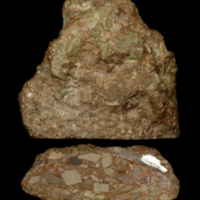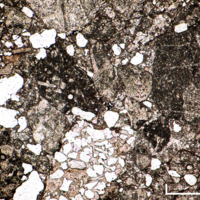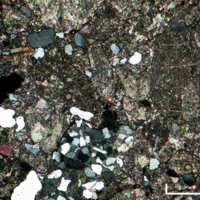- Home
- Rocks
- Type fossils
- Fossil Specimens
- Minerals
- Glossary
- Stratigraphic Chart
- Michel-Levy Chart
- Classification of igneous rocks
- University of Cambridge
- Department of Earth Sciences
- ESC Library
- Moodle
- Sedgwick Museum
- DoITPoMS
- Mindat.org
- Microfossils
- Bryozoans
- Webmineral
- Tree of Life
- CrystalMaker
- Virtual Microscope
L310 - Breccia
Specimen Age
Permian
Location
Brockram, Cumbria
Hand Specimen
Very poorly sorted.Angular to sub-angular clasts up to 30 mm long. Randomly orientated.
Clasts mainly pale grey, some white, some red.
Red-brown colour of the fine-grained matrix indicates iron staining.
Matrix and some clasts fizz with acid, indicating that they are made of carbonate. This is a limestone.
Thin-section
Variety of clasts: sedimentary rock fragments, carbonate and feldspar crystals, fine-grained quartz and carbonate, some bioclasts. Clasts are quite angular.
Matrix of very fine-grained clays containing fragments of quartz and carbonate.
Matrix of very fine-grained clays containing fragments of quartz and carbonate.
Rock History
Clast-supported. Clasts are angular, so sediments cannot have been transported far. (NB, if this rock were matrix supported the clasts could have been transported a long way without losing their angularity.)
Probably scree accumulation during desert conditions, from approximately the same horizon as L326.
Probably scree accumulation during desert conditions, from approximately the same horizon as L326.
Advanced Notes
Iron-staining
Hematite(Fe2O3) → red (blood-red, cherry-red, brown-red) iron-staining
Limonite (FeO(OH)•nH2O) → yellow or brown iron-staining
The red-brown colour of this rock is probably produced by hematite.
Rock Name
breccia



